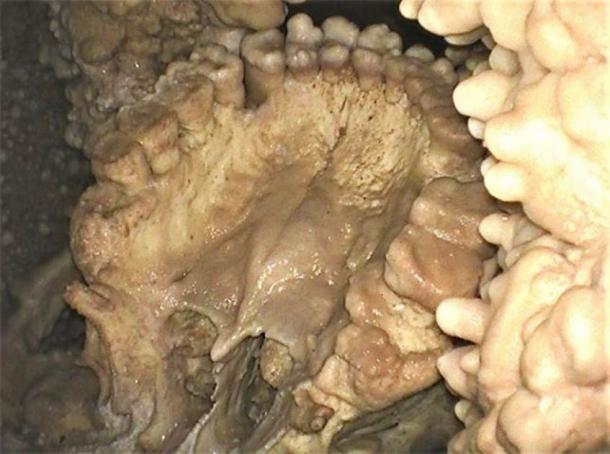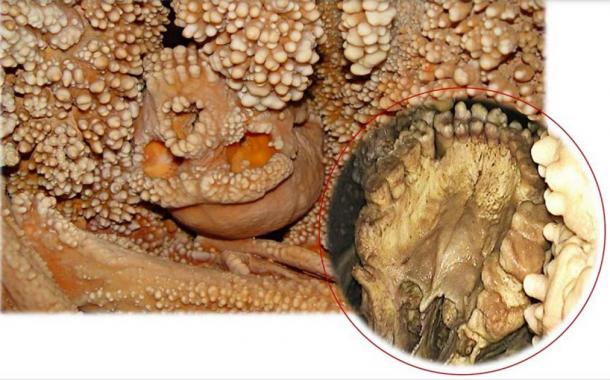Altamura Man was a Neanderthal who lived in southern Italy at least 130,000 years ago. His fossilized skeleton was uncovered by a team of cavers in 1993 AD, entombed within calcite mineral deposits in the karst cave system near Altamura, a town in southern Italy. Altamura Man, the ancient hunter, represents the most complete and best-preserved Neanderthal skeleton ever discovered. But until now his secrets have been locked in time at the bottom of a sinkhole tomb.
In what can only be described as a horrific ancient accident, it is believed that Altamura Man fell into a chasm and starved to death more than 130,000 years ago. His body remains trapped in a deep chamber within the cave system. Dr Jacopo Moggi-Cecchi, a professor in the department of biology at the University of Florence, has published a paper presenting new data about the Altamura Man in the journal PLOS. Regarding how the man got down the hole in the first place the researcher told CNN Edition that perhaps he didn’t see the hole in the ground, and that after he fell in, unable to climb out on his own, he just “sat there and died”. Horrific, as I said.
Targeting Altamura Man’s Ancient Teeth
Altamura Man was a Neanderthal hunter who lived somewhere between 130,000 to 172,000 years ago. However, his ancestors hunted in what is today central Europe and Asia at least 250,000 years before that. The Neanderthal species finally died off about 40,000 years ago which means they existed alongside Homo sapiens for more than 30,000 years, and it´s known that the two species mated.
The 2010 publication of the Neanderthal draft genome sequence proved ancient hominins bred with the ancestors of modern humans and that about “2 percent of the DNA in the genomes of modern-day people with Eurasian ancestry is Neanderthal in origin.”

Forensic evidence obtained from Altamura Man’s mouth showed that he had dental calculus and suffered from gum disease. ( Sapienza Universita de Roma )
The new study was performed solely in the deep recesses of the cave and required a wide array of digital imagery equipment. High resolution photographs and X-rays were combined with footage from videoscopes, which were all captured in the darkness of the sinkhole at the scene of the 130,000-year-old accident.
The study presents the results of an analysis of the male adult Altamura Man’s jawbone, which reveals he had an almost full set of teeth, forty-two in total. And speaking about the state of Altamura Man’s gnashers Dr Moggi-Cecchi said “they were in good shape.” However, dental calculus was identified, and the roots of some teeth were exposed suggesting he had suffered from gum disease .

A closeup of Altamura Man’s mouth and teeth on the lower right. ( Sapienza Universita de Roma )
Altamura Man Was A Toothy Fellow, With Three Hands
The research paper describes the man as having had a “Toothy grin and ‘third hand’.” Dr Moggi-Cecchi explained that this “third hand” actually refers to the ancient man’s front teeth . Marks on the teeth made it evident that the man had habitually used them to hold meat in place, most probably while cutting it, or when stretching animal skins during leather preparation.
However, even though so much new information has been gathered about this ancient man, the vast majority of dietary and lifestyle data remains locked within the calcite lump within the cave, for now.
The researchers point out that their entire study is based on information gleaned only by “looking” at the specimen, in situ, and they can only imagine the profundity of answers that will become available if the fossil was ever removed from the cave and studied in laboratory conditions.
If the researchers’ dreams were to come true, and extraction of the body ever becomes viable, Dr Moggi-Cecchi says the possibilities are immense. For if the team can gather the depth of information presented in their new paper, simply by looking at the fossil, its extraction could see it become “the Neanderthal version of Otzi the Iceman,” the 5300-year-old frozen body discovered in the northern Italian Alps in 1991 AD.
The full report is available via PLoS; DOI: https://doi.org/10.1371/journal.pone.0241713
Top image: Altamura Man’s head, mouth open, as found in the deep Italian cave. Source: Sapienza Universita de Roma
By Ashley Cowie
 RSS Feed
RSS Feed















 December 4th, 2020
December 4th, 2020  Awake Goy
Awake Goy  Posted in
Posted in  Tags:
Tags: 













